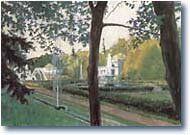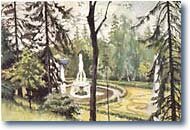BENOIS FAMILY MUSEUM
The Benois Family Museum was inaugurated in 1988. Nikolai Alexandrovich Benois, an outstanding theatrical designer and an Honorary Member of the USSR Academy of Fine Arts, pioneered its foundation. A large contribution to the collection was also made by other members of this artistic clan, various organizations and private persons. The museum display introduces to a broad range of the 19th-20th century cultural phenomena. Graphics and architecture, stage settings and sculpture, painting and cinema, music and literature - all these arts were promoted by the Benois to a considerable extent.
Confectioner Louis Jules Benois (1770-1822) arrived in Russia from France in 1794. His son Nikolai Leontievich became an architect and the Benois family was integrated into the artistic life of Petersburg. The air of art worship dominating the architect's home stimulated shaping of artistic inclinations of the children and revealing of their talents. Their father, Nikolai Leontievich Benois (1813-1898), rendered a major influence. His brightest period fell on 1847-1858 when he was commissioned to build numerous projects for Peterhof including the court stables, the station pavilion and the Court Ladies' buildings, one housing now the Benois Family Museum.
Nikolai L. Benois' junior son, Alexander Nikolayevitch (1870- 1960), was spell-bound with painting, theatre and architecture from his childhood. Later he became the ideologist of the Mir Iskusslv (the World of Art) magazine and the leader of the namesake association where he was highly commended as a manager and an art critic.
Peterhof was a keynote in Alexander Nikolayevitch Benois' works. His Peterhof water-colours are imbued with aspiration to show the harmony of the man-made and natural beauty.
Alexander Nikolayevitch Benois was closely linked with the rise of the Russian theatrical setting art, which won a world recognition at the famous Russian Seasons in Paris and London. There indeed art integrated music, singing and dancing in a sonorous scenic action.
Albert Nikolayevitch Benois (1852- 1936), the elder son of Nikolai L. Benois, was famed as a water-colourist. His works of the 1880- 1890s are noted for fresh apprehension of nature and brilliant execution.
Alexander's son, Nikolai Alexandrovitch Benois (1901-1988), began working for theatre from his early years. The artist lived abroad from the late twenties and winning recognition was invited to manage the world renowned La Scala setting section in Milan in 1936. Nikolai A. Benois designed about 300 productions of La Scala and other prominent companies of the world. The junior daughter of Alexander Nikolayevitch, Yelena Benois-Clemans (1898-1972), featured a specific talent in apt combining of classic traditions of old-style European masters and expressive means of novel art trends. The study-room of Alexander Nikolayevitch Benois introduces into the atmosphere of the work of the remarkable master.
The Benois family brought forth professional musicians too. The prominent composer Nikolai Cherepnin (1873-1945), the husband of Maria, Albert Nikolayevitch Benois' daughter, gave birth to a dynasty of composers: his son Alexander and grandsons Ivan and Sergey much contributed to the European musical culture.
Ivan Vyshnegradskv (1893-1979), the husband of Yelena Benois, was a talented composer and a pioneer in the 20th-century music.
Disma de Cecco, the wife of Nikolai A. Benois, remained a leading solo singer of the famed La Scala company for many years. Leonty Benois (1856- 1928) became an architect as his father Nikolai L. He took part in designing of the Petersburg Court Choir Chapel (the Mikhail Glinka Academic Choir Chapel now), the Pechatny Dvor Printing House, the Exposition Building of the Emperor Alexander III Museum (incorporated at present into the Russian Museum), the Institute of Obstetrics and Gynecology, a building for the Ministry of Foreign Affairs in Moscow and the Likani Palace in Georgia. He invariably featured strict composition, integral array and exquisite decoration of constructions.
Leonty's daughter, Nadezhda (1895-1975), was a graphic artist well known in Britain as a book illustrator.
The famous actor, drama director and author Peter Ustinov (b. 1921) is Nadezhda's son. Launching upon his career at the theatre he went over to cinema participating in more than fifty productions. Remarkable are Peter Ustinov's literary works and his public activities. The notable sculptor Yevgeny A. Lanceré (1848-1886), the husband of Nikolai L. Benois' daughter Catherine, highly talented in observation and penetration into the environment combined with bright imagination and inventive faculty, managed to avoid naturalism and retain his individuality adhering to the prevailing style of realistic representation of minute details. After the early death of Yevgeny A. Lanceré his children were brought up in the family of their grandfather Nikolai L. Benois. The sculptor's son Yevgeny Ye. Lancere (1875-1946) entered the school of the Society of Encouragement of Arts in 1892 and went to Paris in 1895 to complete his education at the famous Colarossi Academy. He was largely influenced by the young Petersburg artists: A. N. Benois, A. Ostroumova, K. Somov and L. Bakst. Their contacts continued within the Mir Iskusstv framework. Yevgeny Ye. Lanceré, as well as his friends, was greatly inspired with the history of Russia. He contributed a lot to the Zritel and Zhupel satirical magazines at the time of the first Russian revolution of 1905 and went to live in the Caucasus after the October Revolution of 1917 working much on landscaping and designing stage settings for Odessa, Moscow and Kutaissi theatres. Having removed to Moscow he painted (1930s) the interior of the Moscow Kazan Railway Station and the Moskva Hotel and sketched mosaic panels for the Komsomolskaya subway station.
Yevgeny's junior brother, Nikolai Lanceré (1879- 1942), went into architecture. The best works of his early period include the Novinsky House and the Folk Art School in Petersburg and the V. Kochubey Mansion in Tsarskoye Selo (jointly with A. Tamanian). After the October Revolution of 1917 Nikolai Lanceré became a prominent figure in the constructivism style. In 1929 he was highly commended at the International Contest for his design of a monument- lighting house to Christopher Columbus in Santo Domingo. Nikolai Lanceré was arrested on false evidence in 1938 and died in jail. Zinaida Serebriakova (1884-1967), Nikolai Ye. Lanceré's sister, enjoyed total success with her Making-Up self-portrait (1909). In the years to follow Z. Serebriakova painted a series of pictures of the Russian countryside.
She went to France in 1924 where she painted an array of portraits of Russian intellectuals. Warm and penetrating are her portraits of children. A tribute to Zinaida Serebriakova was paid by the expositions of her works arranged in the Soviet Union in 1965 and 1987.
All her children followed in her step.
Yevgeny Serebriakov (b. 1906), an architect, designed a number of buildings in Leningrad, Khabarovsk and Tallinn. The names of Alexander (b. 1907) and Catherine (b. 1913) have been well known in the artistic walks of France and other countries for half a century. Tatiana Serebriakova (1912-1989), a merited artist, worked as a theatrical settings designer in Leningrad and Moscow. The classic of Armenian architecture Alexander Tamanian (1878-1936) was the husband of Camilla Edwards, Nikolai L. Benois' grand-daughter. His works combine compositional approaches of the Russian Classicism with adaptation of the Armenian national architectural traditions. Georgi Tamanian (b. 1910) took after his father participating in building many structures which became some prominent landmarks of Yerevan, to quote the A. Khachaturian Concert Hall, the Armenian Government House, the A. Spendiarov Opera and Ballet Theatre and others. Login Schroeter (1908- 1988) was born in Petersburg to the family of architect Ludwig Schroeter and Catherine Benois. Under his guidance the Lenproject Civil Engineering Institute Design Shop No. 2 developed some most remarkable architectural sites of the Vyborg District. Alexander A. Benois, pseudonym Konsky, (1852- 1928), as well as his cousin Albert N. Benois, won recognition by his gently lyrical water-colours. The son of Alexander Benois-Konsky, Albert A. (1880-1960), an architect and water-colourist, was celebrated for the construction of the St. Jenevieve de Bois Church near Paris.
Mikhail Benois (1912- 1955), the great-grandson of Nikolai L. Benois, co-authored with prominent architect I. Fomin in building apartment houses in Leningrad.
Piotr Braslavsky (b. 1930), Alexander N. Benois' grandson, a notable architect and a European architecture prize winner, works in France. Piotr Braslavsky tends to diversify architectural forms using prefabricated standard components. The new Cannes Festival Palace built lately in cooperation with Sir Benette and F. Truet is a most outstanding composition.
The young generation of this glorious family of artists is represented at the Museum by artists I. Nikolaev and M. Dedova-Dziadushinskaya, sculptors I. Ustinov and Ye. Lanceré, Jr., architect V. Benois and graphic artists S. Pavlinov and G. Filchakov.
|


The Maids of Honour Buildings.


The Great Palace
from the Palace Church.


The Great Palace.
The Building under the
Coat of Arms.


The Large Flowerbeds
by the Great Palace.


The Lower Fountain
by the Cascade.


Marly.
The Dressing Room
of Catherina I.


The Palace of Monplaisir.

|

![]()
![]()


